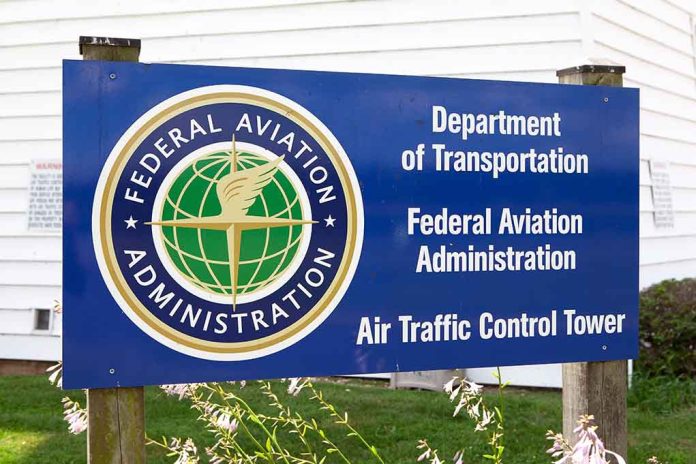
Transportation Department unveils lucrative $30,000 salary increases and multi-tiered bonus structures to fill massive 3,000 air traffic controller gap after years of staffing neglect endangered American air travelers.
Key Takeaways
- The Department of Transportation is addressing a critical shortage of 3,000 air traffic controllers with an aggressive hiring and retention plan
- New hires will receive a 30% salary increase and a $5,000 bonus for completing the FAA Academy training program
- Transportation Secretary Sean Duffy’s plan aims to achieve full staffing within 3-4 years through streamlined hiring and additional training resources
- The program includes retention bonuses for senior controllers approaching the mandatory retirement age of 56 to preserve expertise
- Additional incentives target controllers willing to work at less popular facilities to ensure comprehensive national coverage
DOT Launches Aggressive Controller Recruitment Plan
President Trump’s Transportation Department is taking decisive action to address the dangerous shortage of air traffic controllers that has plagued America’s aviation system. Transportation Secretary Sean Duffy announced a comprehensive plan yesterday to boost hiring and ensure air travel safety amid a staffing crisis that has left the Federal Aviation Administration short by approximately 3,000 controllers nationwide. The initiative aims to achieve full staffing levels within the next three to four years through a combination of accelerated recruitment, enhanced training, and strategic retention of experienced personnel already in the system.
The plan addresses long-standing inefficiencies in the controller pipeline that have contributed to the current crisis. Duffy’s approach includes streamlining the hiring process for the FAA Academy in Oklahoma City, where previously a concerning 35% of trainees failed to complete the program. This high washout rate has perpetuated the staffing shortage and wasted valuable training resources, placing unnecessary strain on existing controllers who have been forced to work overtime to maintain operational safety at America’s airports.
Significant Financial Incentives Drive Recruitment Strategy
The centerpiece of the DOT’s new approach includes substantial financial incentives designed to attract qualified candidates to the profession. New controller recruits will receive a 30% salary increase compared to previous starting wages, making the positions far more competitive with private sector opportunities. Additionally, candidates who complete the rigorous FAA Academy training program will receive a $5,000 bonus, creating an immediate reward for those who demonstrate the necessary skills and commitment required for this safety-critical profession.
The department is also addressing the specific challenges faced by trainees during the technical certification process. Additional educational resources will be provided to help students master the complex material and pass the required examinations. This support system represents a significant investment in ensuring that more candidates successfully transition from training to active controller positions, directly addressing the pipeline problems that have contributed to the current staffing emergency.
Strategic Retention of Experienced Controllers
Recognizing that hiring alone cannot solve the staffing crisis, the Transportation Department has negotiated a deal with the National Association of Air Traffic Controllers focused on retaining experienced professionals. The agreement includes targeted bonuses for senior controllers approaching the mandatory retirement age of 56, incentivizing them to remain in their positions rather than taking early retirement. This retention strategy preserves critical expertise within the system while new controllers are trained, ensuring continued operational safety during the staffing transition.
The plan also acknowledges geographical staffing challenges by offering signing bonuses to controllers willing to work at less popular tower locations. This targeted approach addresses specific facilities that have historically struggled to attract and maintain adequate staffing levels, ensuring that all parts of the national airspace system receive appropriate coverage. These comprehensive incentives are expected to remain in place for several years until staffing levels reach their designated targets.
Technology Upgrades to Support Modernization
In addition to addressing immediate staffing concerns, Secretary Duffy indicated that the Department of Transportation plans to announce significant air traffic control technology and infrastructure upgrades shortly. These improvements will complement the workforce expansion by modernizing the tools available to controllers, potentially reducing workload and increasing efficiency throughout the system. The technological enhancements represent a holistic approach to air traffic management that combines human expertise with advanced systems.
The comprehensive nature of the DOT’s plan reflects President Trump’s commitment to resolving infrastructure challenges that impact American citizens daily. By addressing both immediate staffing shortages and long-term technological needs, the administration is taking steps to ensure that the nation’s air traffic control system remains safe, efficient, and capable of meeting growing demand. The success of these measures will be closely monitored as implementation progresses over the coming months and years.







